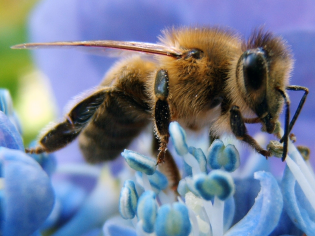 If there’s one thing people around the world love to do — in fact, need to do — it’s eat. Unfortunately, another thing everyone likes to do is talk on their cell phones. And according to a new study (PDF), these two activities are completely at odds because of a cell phone signal’s confusing effects on one key player: bees.
If there’s one thing people around the world love to do — in fact, need to do — it’s eat. Unfortunately, another thing everyone likes to do is talk on their cell phones. And according to a new study (PDF), these two activities are completely at odds because of a cell phone signal’s confusing effects on one key player: bees.
Researcher Daniel Favre of the Swiss Federal Institute of Technology has found that wireless signals cause honeybees to become so disoriented that they finally just die. Favre’s team conducted 83 separate experiments that tested bees’ reactions to a nearby cellphone.
The team found that honeybees made 10 times the amount of noise when a cell phone made or received a call than they did when the phone was in off or standby mode. As Fast Company reports, this noise (generally known as “worker piping”) usually signals the bees to leave the hive. But when the reaction is triggered by a cellular signal, the bees just became tragically befuddled.
So, what about a cell phone signal makes bees suicidally crazy? As Favre’s report explains: “Worker piping in a bee colony is not frequent, and when it occurs in a colony, that is not in a swarming process, no more than two bees are simultaneously active…The induction of honeybee worker piping by the electromagnetic fields of mobile phones might have dramatic consequences in terms of colony losses due to unexpected swarming.”
It’s the “dramatic…colony losses” part that everyone should be concerned about. Honeybees are responsible for pollinating about 70 percent of the 100 or so crops on the entire planet that humans use for food.
So-called “colony collapse disorder” among the world’s bee population has been recorded since 1972. But it wasn’t until 2006 that the drop in the bee population took a nosedive, with beekeepers noting a 30 to 90 percent loss of their bee colonies, up from 17 to 20 percent in previous years.
Favre’s study corroborates a 2008 report that showed that honeybees would not return to their hive when a cell phone was placed nearby, which sparked the theory that wireless signals are the problem.
There are other reasons scientists believe the world’s crucial bee population is plummeting, things like the use of clothiandin, a pesticide used to treat corn seeds. But Favre’s study shows that our cell phone habit is playing a major role in the current bee holocaust. New iPhone, anyone?


